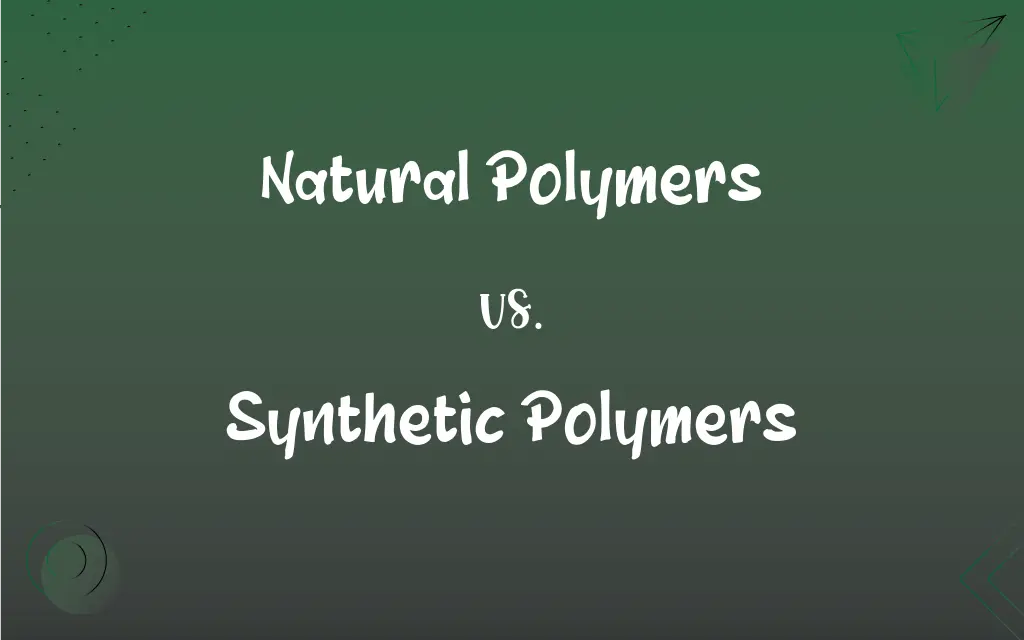Natural Polymers vs. Synthetic Polymers: What's the Difference?
Edited by Janet White || By Harlon Moss || Updated on October 16, 2023
Natural polymers occur in nature and have not been chemically modified, while synthetic polymers are man-made using chemical processes.

Key Differences
Natural polymers are macromolecules that exist naturally within the environment. Examples include DNA, cellulose from plants, and proteins in our bodies. These polymers have evolved over millions of years to perform specific biological and mechanical functions. Their molecular structures are intricately tied to their function, and their synthesis is governed by the laws of biology.
On the other hand, synthetic polymers are man-made polymers developed by scientists to perform specific functions not found in natural polymers. They are the result of targeted research, aiming to produce materials with particular properties. These can range from the plastics we use daily to high-performance materials used in aerospace and medicine. Their synthesis often involves chemical reactions using monomers derived from oil, coal, or natural gas.
While natural polymers have been used by humans for centuries, think silk or wool, our understanding and ability to manipulate them have grown significantly in recent years. With biotechnology's rise, natural polymers are now being used in advanced applications, from drug delivery to tissue engineering.
Synthetic polymers, by virtue of their design, can be tailored to specific needs. They can be made to be more durable, flexible, or resistant than their natural counterparts. However, concerns about their environmental impact, especially their longevity and potential toxicity, have led to increased research into biodegradable synthetic polymers.
In summary, while both natural polymers and synthetic polymers have their advantages and disadvantages, they are both crucial to modern life. Natural ones connect us with the biological world, while synthetic ones offer unprecedented functionality.
ADVERTISEMENT
Comparison Chart
Origin
Found in nature without human modification
Man-made through chemical processes
Examples
DNA, cellulose, proteins
Polyethylene, polystyrene, nylon
Durability
Typically biodegradable
Can be non-biodegradable
Source Materials
Biological entities like plants and animals
Often derived from petrochemicals
Environmental Impact
Generally eco-friendly and decompose naturally
Potential pollutants; some are non-degradable
ADVERTISEMENT
Natural Polymers and Synthetic Polymers Definitions
Natural Polymers
Naturally occurring substances with high molecular weight.
The natural polymer chitin forms the exoskeleton of insects.
Synthetic Polymers
Large molecules produced by joining small molecules together through chemical synthesis.
Teflon, a synthetic polymer, is known for its non-stick properties.
Natural Polymers
Macromolecules that have not undergone chemical alterations from their original state in nature.
Wool, a natural polymer, has been used for centuries to make clothing.
Synthetic Polymers
Macromolecules engineered to have specific characteristics and functions.
Kevlar, a synthetic polymer, is used in bulletproof vests.
Natural Polymers
Polymers derived from plants or animals without synthetic modifications.
Silk, a natural polymer, has been coveted for its smooth texture.
Synthetic Polymers
Man-made polymers created via chemical reactions.
Polyvinyl chloride (PVC) is a synthetic polymer used in pipes.
Natural Polymers
Complex molecules found in biological systems, with a natural origin.
Starch, a natural polymer, is an energy source for many organisms.
Synthetic Polymers
Polymers that are not naturally occurring and are made by human intervention.
Nylon, a synthetic polymer, is widely used in clothing.
Natural Polymers
Large molecules composed of repeating structural units found naturally.
Cellulose in plants is a natural polymer used to make paper.
Synthetic Polymers
Compounds formed by chemical processes in labs or industries.
Polystyrene, a synthetic polymer, is commonly used in packaging materials.
FAQs
Where are synthetic polymers used?
Synthetic polymers are used in various products like plastics, clothing, and medical devices.
Can synthetic polymers be made eco-friendly?
Yes, research is ongoing to create biodegradable and eco-friendly synthetic polymers.
Why are synthetic polymers a concern for the environment?
Some synthetic polymers are non-biodegradable, leading to pollution and environmental harm.
Are natural polymers biodegradable?
Most natural polymers are biodegradable, breaking down naturally in the environment.
What are natural polymers?
Natural polymers are macromolecules found in nature, like DNA, proteins, and cellulose.
Why might manufacturers choose synthetic polymers over natural ones?
Synthetic polymers can be tailored to have specific properties, making them suitable for specialized applications, and they might be more consistent in quality or cheaper to produce at scale.
What role do natural polymers play in the medical field?
Natural polymers like collagen and chitosan are used for wound healing, drug delivery, and tissue engineering due to their biocompatibility.
Can synthetic polymers be recycled?
Many synthetic polymers, like PET and HDPE, can be recycled, but the recyclability varies depending on the type of polymer and the presence of additives.
Why are some natural polymers like rubber treated or modified?
Some natural polymers are treated to enhance their properties, as in the case of rubber being vulcanized to make it more durable and less sticky.
What's a common example of a natural polymer?
Cellulose in plants, used to make paper, is a common natural polymer.
What drives the creation of new synthetic polymers?
The need for materials with specific properties, not found in natural polymers, drives the development of new synthetic polymers.
What are the sources of natural polymers?
Natural polymers primarily come from biological entities, such as plants, animals, and microorganisms.
How long have humans been using natural polymers?
Humans have been using natural polymers for millennia, from making tools out of bone to weaving with plant fibers.
Are there health concerns related to synthetic polymers?
Some synthetic polymers can release toxic compounds, but many are considered safe for their intended uses.
Can natural polymers be used in high-tech applications?
Yes, with advancements in biotechnology, natural polymers are used in areas like drug delivery and tissue engineering.
Are all synthetic polymers derived from petroleum?
While many synthetic polymers come from petrochemicals, there are also bio-based synthetics derived from renewable resources like corn or sugarcane.
Are there any natural polymers in our body?
Yes, our bodies contain several natural polymers, such as DNA, proteins, and polysaccharides like glycogen.
How are synthetic polymers produced?
They are produced through chemical reactions, often using monomers derived from petrochemicals.
Do synthetic polymers pose a risk to wildlife?
Some synthetic polymers, especially microplastics, can pose risks to wildlife when ingested or when they enter natural habitats.
Can the properties of synthetic polymers be modified?
Yes, by altering their chemical structure or by adding different additives, the properties of synthetic polymers can be tailored to specific needs.
About Author
Written by
Harlon MossHarlon is a seasoned quality moderator and accomplished content writer for Difference Wiki. An alumnus of the prestigious University of California, he earned his degree in Computer Science. Leveraging his academic background, Harlon brings a meticulous and informed perspective to his work, ensuring content accuracy and excellence.
Edited by
Janet WhiteJanet White has been an esteemed writer and blogger for Difference Wiki. Holding a Master's degree in Science and Medical Journalism from the prestigious Boston University, she has consistently demonstrated her expertise and passion for her field. When she's not immersed in her work, Janet relishes her time exercising, delving into a good book, and cherishing moments with friends and family.































































